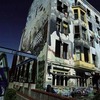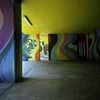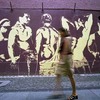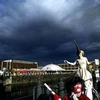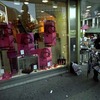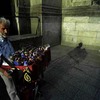Berlin exhibition stirs painful memories
Even before it opened its doors, the exhibition "Forced Paths" attracted a lot of controversy in the German and Polish media.
The aim of the organisers of the exhibition at the Kronprinzenpalais on Berlin's Unter Den Linden Avenue is ambitious - to explore the plight of millions of people who were forced to flee their homes in Europe during the 20th Century.
There are dozens of examples of civilians who were expelled in Europe, ranging from the mass killing of Armenians from 1915-16, the Holocaust, to refugees in Cyprus and the former Yugoslavia.
There are many objects on display, including suitcases, photo albums and other personal belongings which the refugees took with them into exile.
But, controversially, the exhibition also focuses on the suffering of Germans who were expelled from Poland and Eastern Europe after World War ll.
The exhibition has been organised by a foundation closely linked to the Federation of the Expelled, which represents 12 to 14 million ethnic Germans, and their descendants, who were forced from their homes.
"It's clear that expulsion in the 20th Century was a common instrument of politicians who did not pay any regard to the fate of humans," said Erika Steinbach, president of the Centre Against Expulsions Foundation.
For Ms Steinbach, who is a Christian Democrat politician, this exhibition is seen as the first step towards setting up a permanent centre in Berlin to remember the millions of Germans who were expelled after WWll.
But that is highly controversial, and many politicians and other groups in Germany are opposed to the idea.
The organisers are hoping that the exhibition will focus attention on the plight of ethnic Germans who were driven from their homes, but also the plight of many other Europeans.
"It's probably not well-known outside Germany that at the end of World War ll, around 12 million Germans had to leave their homes in the former eastern German provinces and elsewhere," said Wilfried Rogasch, the curator of the exhibition.
"It was the largest forced migration in the history of modern Europe. We show this in European context."
But the exhibition has angered many people in Poland and several dozen Poles staged a demonstration outside the gallery in Berlin on the opening night.
Polish Prime Minister Jaroslaw Kaczynski has condemned the exhibition as a "very bad, worrying and sad event," as it "relativised the history of the World War ll".
The acting mayor of Warsaw, Kazimierz Marcinkiewicz, has cancelled a trip to Berlin, saying he could not visit the city while the exhibition was running.
Erika Steinbach during a preview of the exhibition in Berlin
The exhibition is straining ties between Germany and Poland
"My visit to Berlin could be misinterpreted and abused under these circumstances," he said.
Critics argue that the exhibition is an attempt to re-write history, claiming that Germans are portrayed mostly as victims and the role of the Nazi regime is overlooked.
"We think that the struggle against totalitarianism, Nazism and Communism, and the resistance movements, were the most important parts of 20th Century history. The expulsion, especially of Germans, was only a consequence of that," said Slawomir Tryc from the Polish embassy in Berlin.
But the exhibition's curator says Germans should be able to explore all aspects of history.
"I think it's significant to show that Germans were victims after World War ll," said Mr Rogasch.
"We know that Germans committed many crimes, and that's well documented. More than 60 years after the end of the war, we can start to focus on the fate of 12 million Germans who were expelled. This is an important part of our national history."
Relations between Berlin and Warsaw are strained, and given the reaction to this exhibition from the Polish government, it is likely to deepen the mistrust between the neighbouring countries.
By Tristana Moore
BBC News, Berlin
Comments
It almost sounds like you’re implying that if you call your victims Nazis, you can commit atrocities against them: “controversially, the exhibition also focuses on the suffering of Germans who were expelled from Poland and Eastern Europe after World War ll”. What’s controversial about that?
Reply